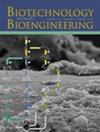通过解码和利用渗透应激反应基因靶标,工程解脂耶氏菌高效生产赤藓糖醇。
IF 3.6
2区 生物学
Q2 BIOTECHNOLOGY & APPLIED MICROBIOLOGY
引用次数: 0
摘要
代谢工程已被证明对提高脂性耶氏菌赤藓糖醇的产量是有效的,而目前的方法仍然受到实验室菌株和劳动密集型基因修饰的限制。为了解决这些挑战,本研究通过系统地研究聚脂耶氏菌CA20在赤藓糖醇发酵过程中的渗透胁迫响应机制,并确定细胞生长和赤藓糖醇生物合成的关键遗传决定因素,开发了一种简化的工程策略。整合转录组学和代谢组学分析显示,核苷酸、脂质、氨基酸、辅助因子和维生素代谢是渗透适应所必需的,通过靶向基因过表达实验证实了这一点。有趣的是,虽然这些修饰提高了细胞活力,但它们并没有始终提高赤藓糖醇的产量。此外,A000169和A004467基因分别编码一种假设蛋白和一种GPR1/FUN34/YaaH家族蛋白,被证明与赤藓糖醇的产生密切相关。A000169的过表达结合A004467和EYD1的缺失产生了一株健壮的聚脂耶氏菌EG01,能够生产赤藓糖醇,其最大滴度为218.70 g/L,产率为2.27 g/L/h,相对于原始菌株CA20提高了62.96%,超过了之前报道的分批发酵聚脂耶氏菌的赤藓糖醇产量水平。最后,两段补料分批发酵在132 h内可达到赤藓糖醇滴度和产率分别达到276.70 g/L和0.69 g/g。以上研究结果为高效产赤藓糖醇的聚脂酵母的工程设计提供了有价值的线索。本文章由计算机程序翻译,如有差异,请以英文原文为准。
Engineering Yarrowia lipolytica for Efficient Production of Erythritol by Decoding and Harnessing Osmotic-Stress-Responsive Genetic Targets.
Metabolic engineering has proven effective for enhancing erythritol production in Yarrowia lipolytica, while current approaches remain limited by their focus on laboratory strains and labor-intensive genetic modifications. To address these challenges, this study developed a streamlined engineering strategy by systematically investigating the osmotic stress response mechanisms of Yarrowia lipolytica CA20 during erythritol fermentation and identifying key genetic determinants of cell growth and erythritol biosynthesis. Integrated transcriptomics and metabolomics analyses revealed that nucleotide, lipid, amino acid, cofactor, and vitamin metabolism were essential for osmotic adaptation, which was experimentally validated through targeted gene overexpression. Interestingly, while these modifications improved cell viability, they did not consistently enhance erythritol production. Further, genes A000169 and A004467, coding for a hypothetical protein and a GPR1/FUN34/YaaH family protein, respectively, were shown to be closely associated with erythritol production. Overexpression of A000169 combined with deletion of A004467 and EYD1 generated a robust strain, Yarrowia lipolytica EG01, capable of producing erythritol with a maximum titer of 218.70 g/L and a productivity of 2.27 g/L/h, with an increase of 62.96% relative to the original strain CA20, exceeding previously reported production levels of erythritol in Y. lipolytica using batch fermentation. Finally, two-stage fed-batch fermentation could achieve erythritol titer and yield up to 276.70 g/L and 0.69 g/g within 132 h. Overall, these findings provide valuable clues to the engineering of Y. lipolytica capable of efficient production of erythritol.
求助全文
通过发布文献求助,成功后即可免费获取论文全文。
去求助
来源期刊

Biotechnology and Bioengineering
工程技术-生物工程与应用微生物
CiteScore
7.90
自引率
5.30%
发文量
280
审稿时长
2.1 months
期刊介绍:
Biotechnology & Bioengineering publishes Perspectives, Articles, Reviews, Mini-Reviews, and Communications to the Editor that embrace all aspects of biotechnology. These include:
-Enzyme systems and their applications, including enzyme reactors, purification, and applied aspects of protein engineering
-Animal-cell biotechnology, including media development
-Applied aspects of cellular physiology, metabolism, and energetics
-Biocatalysis and applied enzymology, including enzyme reactors, protein engineering, and nanobiotechnology
-Biothermodynamics
-Biofuels, including biomass and renewable resource engineering
-Biomaterials, including delivery systems and materials for tissue engineering
-Bioprocess engineering, including kinetics and modeling of biological systems, transport phenomena in bioreactors, bioreactor design, monitoring, and control
-Biosensors and instrumentation
-Computational and systems biology, including bioinformatics and genomic/proteomic studies
-Environmental biotechnology, including biofilms, algal systems, and bioremediation
-Metabolic and cellular engineering
-Plant-cell biotechnology
-Spectroscopic and other analytical techniques for biotechnological applications
-Synthetic biology
-Tissue engineering, stem-cell bioengineering, regenerative medicine, gene therapy and delivery systems
The editors will consider papers for publication based on novelty, their immediate or future impact on biotechnological processes, and their contribution to the advancement of biochemical engineering science. Submission of papers dealing with routine aspects of bioprocessing, description of established equipment, and routine applications of established methodologies (e.g., control strategies, modeling, experimental methods) is discouraged. Theoretical papers will be judged based on the novelty of the approach and their potential impact, or on their novel capability to predict and elucidate experimental observations.
 求助内容:
求助内容: 应助结果提醒方式:
应助结果提醒方式:


